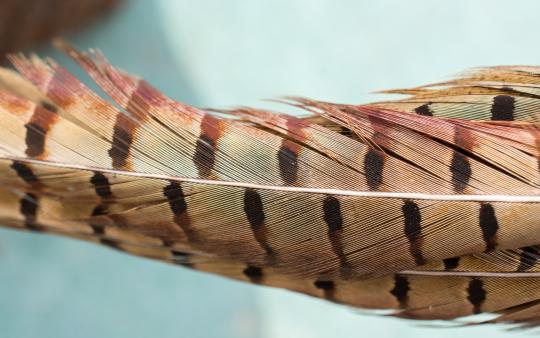Could you imagine birds without their beautiful plumage? Feathers do more for birds than just attract mates or provide camouflage from predators. In fact, feathers evolved from reptilian scales, and birds still have scales in the lower parts of their legs and feet! Scientists believe that the evolution of feathers was primarily a means of keeping warm, and as birds evolved, feathers gradually became longer, stronger, and better-shaped for flight.
Made from keratin (the same stuff you have in your hair and fingernails), feathers emerge from a central shaft, or rachis, with barbs that jut off each side. The barbs are hooked together with barblets which provides extra strength to the feather. It’s why you see birds spending so much time preening themselves—it’s very important that all the barblets are doing their job, which is keeping the feathers smooth and efficient. While preening, birds also coat the feathers with an oil that they produce to make them waterproof. This keeps waterfowl from getting soaked through, and prevents small birds like chickadees from drowning when it rains.
Fun fact: The Ruby-throated Hummingbird has the distinction of being the bird with the least feathers, at only 940, while the Whistling Swan can sport as many as 25,000 feathers in winter!
Feather Fundamentals
A bird is a many-feathered thing! There are several different kinds of feathers, and each have different jobs!
Flight feathers
Flight feathers are the long feathers found on the wings and tail. They have stronger barbules, which give them more strength for flying.
Contour feathers
Contour feathers are found everywhere except the beak, legs, and feet. They give both shape and colour to the bird. At its base, a contour feather becomes downy which helps keep the bird warm.
Down feathers
Down feathers are soft and fluffy, with very little shaft and no barbules. They keep the bird warm by trapping air. These are the feathers that humans collect to put in quilts and parkas.
Semiplumes
Semiplumes are a cross between a contour feather and a down feather. They grow between the contour feathers for extra insulation, and also make the bird look rounder and plumper.
Filoplumes
Filoplumes are very small and have only a few barbs at their tips. They are attached to nerve endings, and send messages to the brain which help birds keep their feathers in order.
Fowl Weather Fun!
Feathers don’t last forever, so don’t be alarmed if you find them around on your walks! Birds are constantly losing worn and tattered feathers and re-growing new ones through a process called moulting. When you come across a feather or two, bring them home, hold them up against a dark background with the light coming from behind you so you can observe the small details clearly. Next, study it with a magnifying glass and identify what kind of a feather it is, and if you can, try to guess which bird it came from!
NatureKids BC is a registered charity that helps children aged 5-12 get outdoors to explore, play, learn about and take action for nature. We do this through a network of family nature clubs that extends across British Columbia and through opportunities to engage in citizen science initiatives and environmental stewardship activities. Already a member? You can use this activity as part of your Action Awards Quest! www.naturekidsbc.ca
You may also enjoy: How to See More Wildlife When You're Exploring in Nature, Five Reasons Orienteering is Your New Favourite Sport, and Nurturing Your Child to be a Naturalist.






